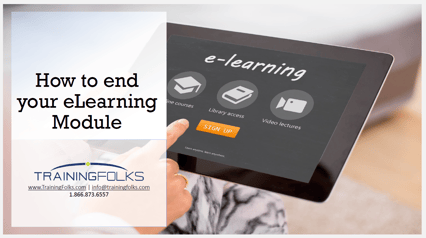The Top Features of Effective eLearning Development

As a business leader, have you ever faced the challenge of onboarding new employees consistently and at the same time, especially when they are located in different time zones and have varying schedules? A rapidly expanding company recently hired a large number of new employees situated in various cities worldwide, and they encountered this exact issue. To maintain their growth trajectory, they needed to onboard their new hires as quickly and effectively as possible.
The company realized that a well-designed onboarding process was crucial to the success of their new employees and to ensure that they felt supported and integrated into the company's culture. To solve this problem, they created a comprehensive online onboarding program that included interactive modules, virtual meetings with key stakeholders, and on-demand access to company policies and procedures. With this approach, they were able to provide a consistent onboarding experience and set their new hires up for success from day one.
One part of solving this challenge is creating custom eLearning programs.
In today's fast-paced world, taking eLearning programs to upskill employees is common in many organizations. In a technology-enabled world, learners can access educational content from anywhere in the world at any time. However, not all eLearning programs are created equal. Effective eLearning programs should have specific features that provide learners with an engaging and effective learning experience. Training departments and eLearning development companies both strive to create training programs that have a positive impact on employees.
Learn about the top features of effective eLearning programs, including clear learning objectives, engaging content, personalization, assessment and feedback, social learning, gamification, and mobile-friendliness. By incorporating these features, eLearning programs can provide learners with a comprehensive and enjoyable learning experience.
Clear Learning Objectives
Effective eLearning programs should have clear and well-defined learning objectives that are communicated to the learners comprehensively and understandably. These learning objectives should be specific, measurable, achievable, relevant, and time-bound to ensure that the learners have a clear understanding of what is expected of them.
By providing learners with clear learning objectives, they will have a better understanding of what they are expected to achieve, which will motivate them to engage with the course content and work towards achieving their learning goals. Moreover, clear learning objectives also help learners to track their progress and assess their understanding of the course material, which ultimately leads to a more effective and engaging learning experience.
Engaging Content
Engaging content is an essential component of effective eLearning programs, and it plays a crucial role in capturing learners' attention and maintaining their engagement throughout the course. The content should be presented in a visually appealing and interactive manner to ensure that learners remain interested and motivated to learn.
To achieve this, eLearning programs should incorporate multimedia elements such as videos, animations, and interactive quizzes that help to break up the monotony of the course material and make the content more interesting and memorable. By integrating multimedia elements, learners can engage with the material in a more immersive and interactive way, which ultimately leads to better retention and understanding of the course content.
Additionally, engaging content can also help to create a more enjoyable and stimulating learning experience, which can lead to increased motivation and participation among learners.
Personalization
Personalization is a critical feature of effective eLearning programs, and it plays a vital role in enhancing the learning experience for learners. Personalization can be achieved by providing learners with the ability to choose their own learning path, allowing them to learn at their own pace, and tailoring the content to their specific interests and needs. By personalizing the learning experience, learners will feel more engaged and invested in the course, which ultimately leads to better learning outcomes.
Personalization can take many forms, and it can be achieved through various means, such as adaptive learning technologies, personalized learning plans, and customized course content. Adaptive learning technologies use data analytics and machine learning algorithms to personalize the learning experience for each learner. Personalized learning plans allow learners to set their own learning goals, track their progress, and receive feedback on their performance. Customized course content involves tailoring the course material to the specific needs and interests of the learners.
By incorporating personalization into eLearning programs, learners can have a more meaningful and relevant learning experience that meets their individual needs. Personalization can also help to increase learner motivation and engagement, as learners are more likely to be interested and invested in the course material if it is tailored to their specific needs and interests. Ultimately, personalization is a critical component of effective eLearning programs, as it can lead to better learning outcomes and increased learner satisfaction.
Assessment and Feedback
Effective assessments should be designed to be challenging yet achievable, and they should provide learners with an opportunity to apply their knowledge and skills to real-world scenarios. Additionally, assessments should be designed to provide learners with immediate feedback on their performance, which can help them to identify their strengths and weaknesses and improve their understanding of the course material.
Feedback is another essential component of effective eLearning programs, and it should be constructive, specific, and timely. Feedback should be designed to help learners understand their strengths and weaknesses, and it should provide them with actionable steps to improve their performance. Additionally, feedback should be designed to be personalized to the individual learner, taking into account their unique learning style and needs.
Social Learning
Social learning refers to the process of learning from and with others, and it can take many forms, such as discussion forums, group projects, and peer reviews. By incorporating social learning features, learners can benefit from the knowledge and experience of others, which can enhance their learning experience.
Discussion forums are a popular social learning tool that allows learners to interact with each other and discuss course material. Through discussion forums, learners can share their perspectives, ask questions, and receive feedback from their peers. Group projects are another effective social learning tool that allows learners to work collaboratively on a project, which can help to develop teamwork and communication skills.
Peer reviews are also an effective social learning tool that allows learners to review and provide feedback on each other's work, which can help to improve critical thinking and analytical skills.
Gamification
Gamification is another important feature of effective eLearning programs. Gamification refers to the use of game design elements in non-game contexts to make the learning experience more enjoyable and engaging. Gamification can include elements such as points, badges, and leaderboards. By incorporating gamification, learners can be motivated to engage with the course content and achieve their learning objectives.
Mobile-Friendly
Effective eLearning programs should be mobile-friendly. Learners should be able to access eLearning programs on their mobile devices. Mobile-friendly eLearning programs should be designed to be responsive and optimized for different screen sizes. By making eLearning programs mobile-friendly, learners can access the content on the go and learn at their convenience.
Conclusion
Effective eLearning programs should have clear learning objectives, engaging content, personalization, assessment and feedback, social learning, gamification, and be mobile-friendly. By incorporating these features, eLearning programs can provide learners with an effective and engaging learning experience.
With the increasing demand for online learning, eLearning programs will continue to play an important role in education and training. As such, it is important for educators and trainers to incorporate these features into their eLearning programs to ensure that learners receive the best possible learning experience.
Ready to learn more on eLearning but not sure where to begin?
Download our FREE eBook
'How to End your eLearning Module'

